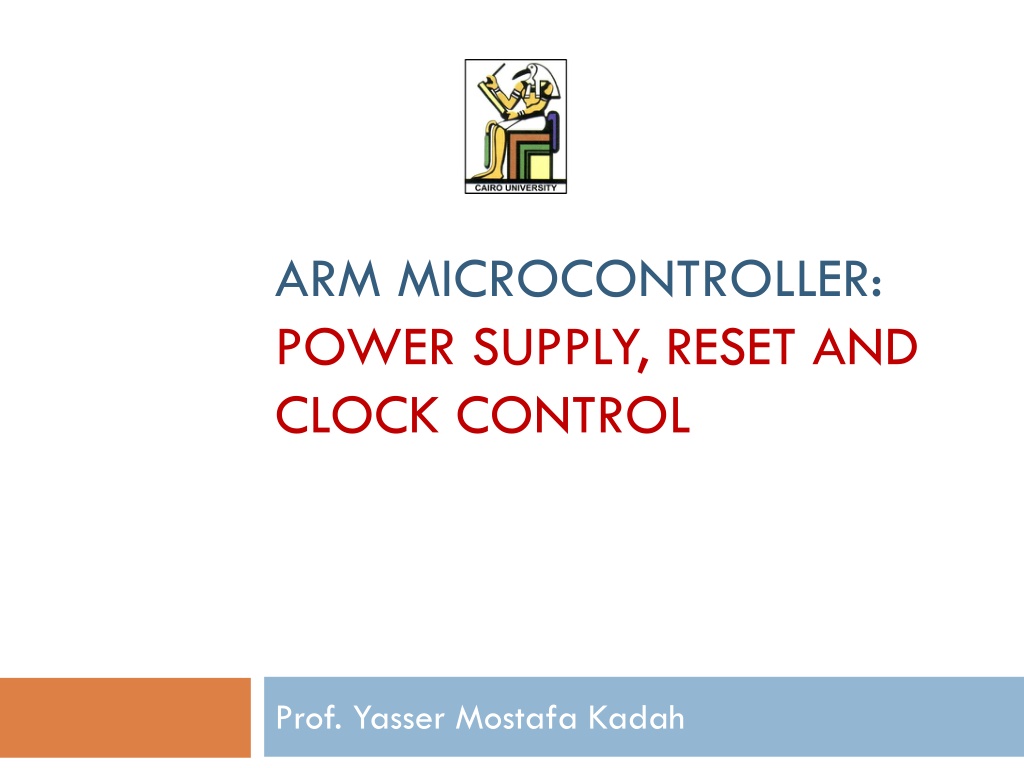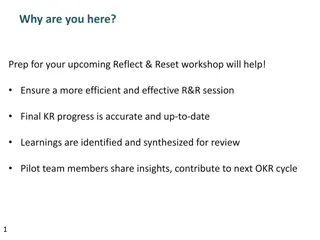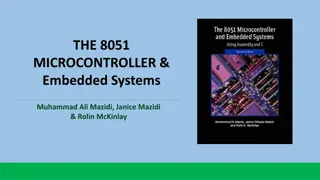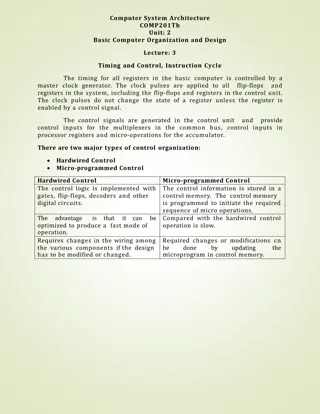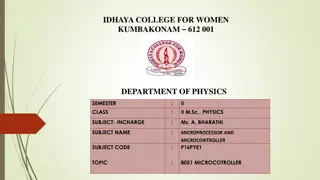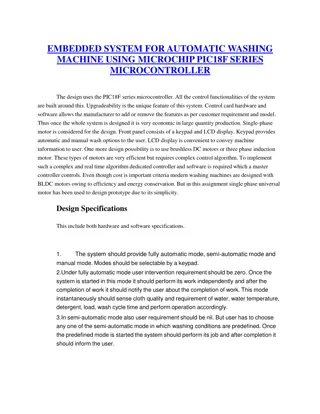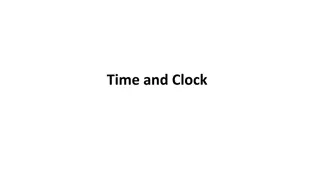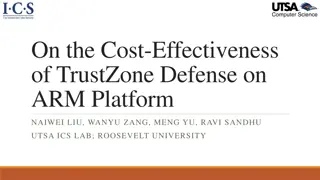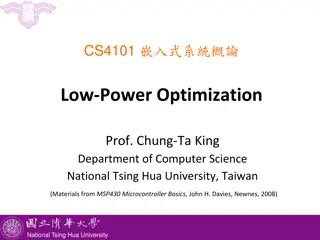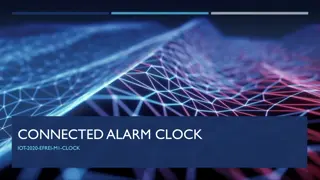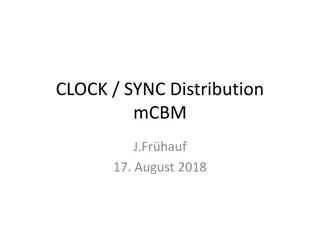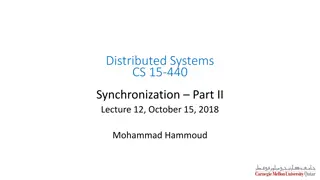ARM Microcontroller Power Supply, Reset, and Clock Control Overview
This overview covers the power supply, reset control, and clock sources for ARM microcontrollers, focusing on aspects such as power supplies, battery backup, voltage regulator operation modes, and power supply supervisor functions. It discusses essential details like operating voltages, backup domain operation, standby modes, and power-on and power-down resets that ensure proper functionality and reliability in ARM-based systems.
Uploaded on Sep 18, 2024 | 0 Views
Download Presentation

Please find below an Image/Link to download the presentation.
The content on the website is provided AS IS for your information and personal use only. It may not be sold, licensed, or shared on other websites without obtaining consent from the author. Download presentation by click this link. If you encounter any issues during the download, it is possible that the publisher has removed the file from their server.
E N D
Presentation Transcript
ARM MICROCONTROLLER: POWER SUPPLY, RESET AND CLOCK CONTROL Prof. Yasser Mostafa Kadah
Recommended Reference STM32F100xx Advanced ARM-Based 32-Bit MCUs, RM0041 Reference Manual, ST Microelectronics (Available Online)
Lecture Contents Power supply Battery backup, voltage regulator, supervisor and Low power modes System reset System clock sources
Power Supplies Device requires a 2.0:3.6V operating voltage supply (VDD) Embedded regulator is used to supply the internal 1.8 V digital power Real-time clock (RTC) and backup registers can be powered from VBATvoltage when main VDDsupply is powered off
Battery Backup Domain To retain the content of the Backup registers and supply the RTC function when VDDis turned off, VBATpin can be connected to an optional standby voltage supplied by a battery or by another source The VBATpin powers the RTC unit, the LSE oscillator and the PC13 to PC15 IOs, allowing the RTC to operate even when the main digital supply (VDD) is turned off The switch to the VBATsupply is controlled by the Power Down Reset embedded in the Reset block
Voltage Regulator The voltage regulator is always enabled after Reset and works in three different modes depending on the application modes: Run mode: the regulator supplies full power to the 1.8 V domain (core, memories and digital peripherals) Stop mode: the regulator supplies low-power to the 1.8 V domain, preserving contents of registers and SRAM Standby Mode: the regulator is powered off. The contents of the registers and SRAM are lost except for the Standby circuitry and the Backup Domain
Power Supply Supervisor Power on reset (POR)/power down reset (PDR) Integrated POR/PDR circuitry that allows proper operation starting from/down to 2 V Device remains in Reset mode when VDD/VDDAis below a specified threshold, VPOR/PDR, without the need for an external reset circuit
Power Supply Supervisor Programmable voltage detector (PVD) Monitors the VDD/VDDApower supply by comparing it to a threshold selected by the PLS[2:0] bits in the Power control register (PWR_CR) PVD is enabled by setting the PVDE bit A PVDO flag is available, in Power control/status register (PWR_CSR), to indicate if VDD/VDDAis higher or lower than the PVD threshold This event is internally connected to EXTI and can generate interrupt
Low-Power Modes By default, microcontroller is in Run mode after a Reset Low power modes are available to save power when the CPU need not to be kept running (e.g., while waiting for an external event) It is up to the user to select the mode that gives the best compromise between low-power consumption, short startup time and available wakeup sources. The STM32F100xx devices feature three low-power modes: Sleep mode (CPU clock off, all peripherals including Cortex-M3 core peripherals like NVIC, SysTick, etc. are kept running) Stop mode (all clocks are stopped) Standby mode (1.8V domain powered-off) In addition, power consumption in Run mode can be reduced by: Slowing down the system clocks Gating the clocks to the APB and AHB peripherals when they are unused.
Backup Registers (BKP) Backup registers are ten 16-bit registers in low and medium density devices for storing 20 bytes of user application data They are implemented in the backup domain that remains powered on by VBATwhen the VDDpower is switched off. They are not reset when the device wakes up from Standby mode or by a system reset or power reset In addition, the BKP control registers are used to manage the Tamper detection feature and RTC calibration. After reset, access to the Backup registers and RTC is disabled and the Backup domain (BKP) is protected against possible parasitic write access To enable access to the Backup registers and the RTC, proceed as follows: Enable the power and backup interface clocks by setting the PWREN and BKPEN bits in the RCC_APB1ENR register Set the DBP bit the Power Control Register (PWR_CR) to enable access to the Backup registers and RTC.
Reset There are three types of reset: System Reset Power Reset Backup domain reset
System Reset A system reset sets all registers to their reset values except the reset flags in the clock controller CSR register and the registers in the Backup domain A system reset is generated when one of the following events occurs: Low level on the NRST pin (external reset) Window watchdog end of count condition (WWDG reset) Independent watchdog end of count condition (IWDG reset) Software reset (SW reset) Low-power management reset
System Reset Software reset The SYSRESETREQ bit in Cortex Control Register must be set to force a software reset on the device -M3 Application Interrupt and Reset Low-power management reset: Method1: Reset generated when entering Standby mode: This type of reset is enabled by resetting nRST_STDBY bit in User Option Bytes. In this case, whenever a Standby mode entry sequence is successfully executed, the device is reset instead of entering Standby mode. Method 2: Reset when entering Stop mode: This type of reset is enabled by resetting NRST_STOP bit in User Option Bytes. In this case, whenever a Stop mode entry sequence is successfully executed, the device is reset instead of entering Stop mode.
Power Reset A power reset is generated when one of the following occurs: Power-on/power-down reset (POR/PDR reset) When exiting Standby mode A power reset sets all registers to their reset values except the Backup domain These sources act on the NRST pin and it is always kept low during the delay phase. The RESET vector is fixed at address 0x00000004 in the memory map
Backup Domain Reset Backup domain has two specific resets that affect only the backup domain backup domain reset is generated when one of the following events occurs: Software reset, triggered by setting the BDRST bit in the Backup domain control register (RCC_BDCR) VDD or VBAT power on, if both have previously been powered off
Clocks Three different clock sources can be used to drive the system clock (SYSCLK): HSI oscillator clock HSE oscillator clock PLL clock The devices have the following two secondary clock sources: 40 kHz low speed internal RC (LSI RC) which drives the independent watchdog and optionally the RTC used for Auto-wakeup from Stop/Standby mode 32.768 kHz low speed external crystal (LSE crystal) which optionally drives the real-time clock (RTCCLK) Each clock source can be switched on or off independently when it is not used, to optimize power consumption
HSE Clock The high speed external clock signal (HSE) can be generated from two possible clock sources: HSE external crystal/ceramic resonator HSE user external clock
HSI Clock The High Speed Internal (HIS) clock signal is generated from an internal 8 MHz RC Oscillator and can be used directly as a system clock or divided by 2 to be used as PLL input The HSI RC oscillator has the advantage of providing a clock source at low cost (no external components) It also has a faster startup time than the HSE crystal oscillator however, even with calibration the frequency is less accurate than an external crystal oscillator or ceramic resonator RC oscillator frequencies can vary from one chip to another due to manufacturing process variations Each device is factory calibrated by ST for 1% accuracy at TA=25 C. After reset, the factory calibration value is loaded in the HSICAL[7:0] bits in the Clock control register (RCC_CR) You can trim the HSI frequency in the application using the HSITRIM[4:0] bits in the Clock control register (RCC_CR)
PLL The internal PLL can be used to multiply the HSI RC output or HSE oscillator divided by 1:16 output clock frequency The PLL configuration (selection of HSI oscillator divided by 2 or HSE oscillator for PLL input clock, and multiplication factor) must be done before enabling the PLL Once the PLL enabled, these parameters cannot be changed The PLL output frequency must be in the range of 16-24 MHz
Low Speed Clocks The LSE crystal is a 32.768 kHz Low Speed External crystal or ceramic resonator It has the advantage providing a low-power but highly accurate clock source to the real-time clock peripheral (RTC) for clock/calendar or other timing functions The LSI RC acts as an low-power clock source that can be kept running in Stop and Standby mode for the independent watchdog (IWDG) and Auto-wakeup unit (AWU) The clock frequency is around 40 kHz.
System Clock (SYSCLK) Selection After a system reset, the HSI oscillator is selected as system clock When a clock source is used directly or through the PLL as system clock, it is not possible to stop it A switch from one clock source to another occurs only if the target clock source is ready (clock stable after startup delay or PLL locked) If a clock source which is not yet ready is selected, the switch will occur when the clock source will be ready Status bits in the Clock control register (RCC_CR) indicate which clock(s) is (are) ready and which clock is currently used as system clock
Clock Security System Clock Security System can be activated by software. In this case, the clock detector is enabled after the HSE oscillator startup delay, and disabled when this oscillator is stopped. If a failure is detected on the HSE clock, the HSE oscillator is automatically disabled, a clock failure event is sent to the break input of the advanced-control timers (TIM1) and an interrupt is generated to inform the software about the failure (Clock Security System Interrupt CSSI), allowing the MCU to perform rescue operations.
RTC and Watchdog Clocks The RTCCLK clock source can be either the HSE/128, LSE or LSI clocks. This is selected by programming the RTCSEL[1:0] bits in the Backup domain control register (RCC_BDCR) This selection cannot be modified without resetting the Backup domain. If the Independent watchdog (IWDG) is started by either hardware option or software access, the LSI oscillator is forced ON and cannot be disabled After the LSI oscillator temporization, the clock is provided to the IWDG
Clock-Out Capability The microcontroller clock output (MCO) capability allows the clock to be output onto the external MCO pin. The configuration registers of the corresponding GPIO port must be programmed in alternate function mode One of 4 clock signals can be selected as the MCO clock: SYSCLK HSI HSE PLL clock divided by 2 The selection is controlled by the MCO[2:0] bits of the Clock configuration register (RCC_CFGR)
Assignments ARM Project #2
